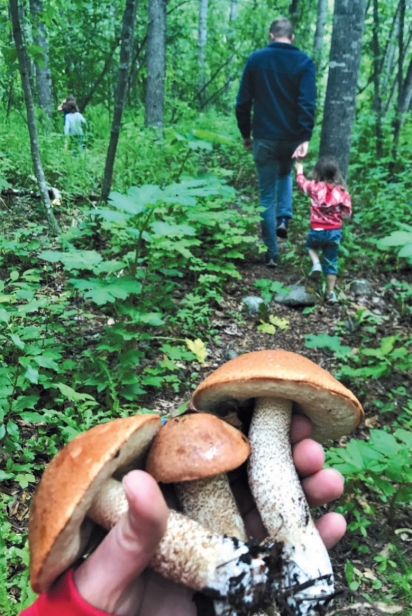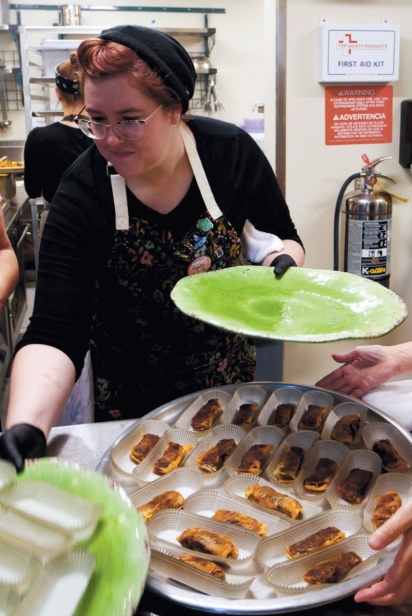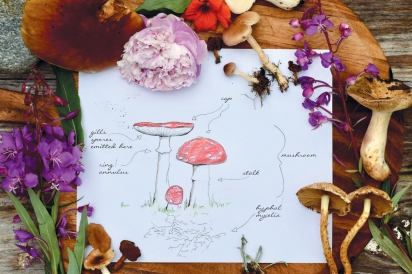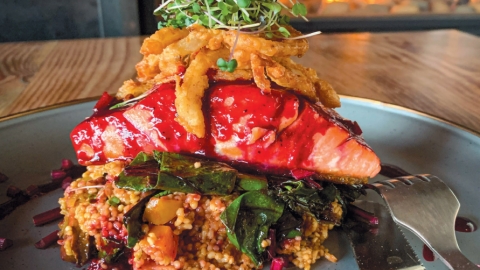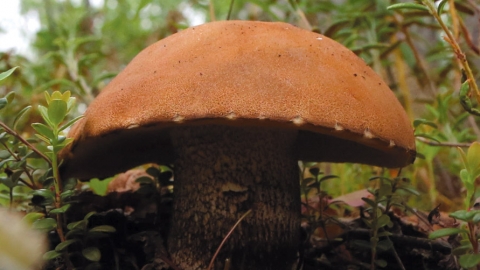Fortuity of the Fungus
I read a recent article that described the world as being pretty much split between mycophiles (those who love and are fascinated by fungi, particularly wild mushrooms) and mycophobes (those who fear and/or avoid fungi, particularly in the wild) without a lot of middle ground.
Whether you identify as a mycophile or mycophobe, you can’t miss our funky fungi friends in Alaska. By the time you read this, the fireweed will likely be in bloom next to cartoonish toadstools (fly agaric), boletes (our version of the porcini), or possibly a slimy russula, tipping its glistening, flaming-red cap as a warning to stay away. Our dogs and children may be stomping on puffballs, mystified by the tiny, harmless spore clouds they fire off in defiant response. Lichens, a complex network between fungi and plant worlds, will be scattered everywhere.
But as I write this in late May and early June, the talk of the town is all morels—the succulent, delicately textured and flavored prize of spring. As predicted, after last year’s wildfires in Alaska, it’s been a big summer for morels. On social media and over text messages people have shared photos of their haul—buckets, crates overflowing. The Swan Lake area proved great for some; for others, it was the burned forests just south of Talkeetna.
For our family—it was a single morel found by the 5-year-old after a weekend of rainy late May mushroom hunting hikes that were a total bust. In an area by our house that I had raked just a few weeks before, that we walked by every day, she led us to five more morels that had seemingly sprung up overnight.
Maybe that’s a big part of the mushroom-hunting appeal in general: uncertainty, the element of complete surprise.
Surprise can, of course, be a double-edged sword and it’s true that we’ve had a lot of surprises this year. Like billions of fungi spores floating around among us at any moment, nearly all major events, including the annual Cordova Fungus Festival and the Girdwood Fungus Fair plans are a bit up in the air, and plans are heading towards dispersed and virtual celebrations. Stay tuned by visiting the Cordova Fungus Festival website or the Girdwood Fungus Fair website.
But even in uncertain times, the fungus will still be there. I mean, for a mycophile, does it get any better than tramping around hunting for mushrooms, displaying mushrooms, photographing mushrooms, making endless jokes and puns about mushrooms, eating mushrooms, looking at (or even wearing) arts and crafts featuring mushrooms, talking and learning about mushrooms and the many, many lenses through which they may be appreciated including fabric dyeing and cultivation—all in the company of local and out-of-state enthusiasts and experts?
“We always get a lot of the same faces, but it attracts a surprisingly broad range of people from all kinds of different backgrounds and professions,” ecologist Kate Mohatt says about the festival.
“There are your foragers, your science types, the outdoors people— artists, visitors, hikers—people who like to be in the forest and just see and learn new things, foodies, photographers….” Kate is the co-president of the Turnagain Arm Mycological Society, or TAMS, and the author of the “Mushrooms of the National Forests in Alaska” publication from the US Forest Service.
After over a decade of grassroots organization (three or four hard-working fungi enthusiasts/experts in Cordova and Girdwood navigating the logistics of putting on a festival for hundreds), TAMS, founded in 2017, now organizes the two festivals every year, enjoying an annual local dinner and drinks together after all the hullabaloo.
Gabriel Wingard, 13, of Anchorage is Co-president of TAMS and his mother, Jennifer Wingard, says the annual fungus fair has become nearly the biggest holiday of the year for him. “Gabriel got interested in mushrooms at three years old, when he went with his dad to the Girdwood Fungus Fair,” she says. He was riveted by the perhaps not-so-kid-friendly cult classic “Know your Mushrooms” shown at the festival and by a giant guidebook later gifted from his grandfather titled Mushrooms Demystified before he could even read.
Gabriel now enthusiastically helps with the festival each year, leading several forays with his mom assisting. “He likes the idea of sparking interest in learning about mushrooms, especially in younger kids, and smiles even thinking about it,” says Jennifer. “Hearing him talk about it, it’s as if he’s describing getting converts to a cause.”
This might include those who do not really enjoy the taste of mushrooms. You may or may not be surprised to learn that Gabriel is not the biggest fan, a trait his mom and others in the society have pointed out to me as actually quite common among mycologists. She says it might seem surprising that a mushroom lover doesn’t dig the taste of mushrooms, “but I think that’s just because of our cultural expectations; no one ever asks birders what species they like best with a glass of Bordeaux.”
Jennifer sums it up for all mycophiles: “What Gabriel likes about mushrooms is the variety, the complexity, the connection with the natural world, the thrill of the hunt, the never-ending quest to find and identify, the community of other enthusiasts, the possibilities for environmental remediation and other applications—in short, just about everything except the taste!”
Regardless of what draws you to ‘shrooms and their ever-surprising ways, here are some local tips that could prove helpful whether you’re an expert or literally just getting your feet wet:
MORE ON MUSHROOMS
Foraging
• “The standard date is Memorial Day in Southcentral Alaska,” says Kate. “Early to Mid-June for Fairbanks on up. And that’s primarily for morel season.”
• When it comes to finding morels, Kate says, “To sum it up, there’s a lot we don’t know and it’s complicated. But things that remove or irritate that duff layer—fire, raking—can trigger the mycelium.” She adds that a lot of research supports the appearance of morels after wildfires; in fact they are commonly called “burn morels.”
• Also from Kate: “Go where there aren’t footprints, get your timing right, and remember that they are patchy, so go with someone else to an area where it’s easy to cover ground, stay in that elevation once you find them, or in a wet seam. The steepness of the terrain doesn’t really matter.”
• From Gabriel and Jennifer: “For edibles, Gabriel and I like finding king boletes, hedgehogs, and yellowfoot chanterelles, all of which involve less competition than morels. By far my favorite non-edible mushroom to find is bird’s nest fungi, because it’s so incredibly cool. Also stinkhorns, because they’re so unabashedly gross.”
• “Learning about mushrooms is a way to bring excitement to hikes, an ongoing, ever-changing treasure hunt, and one important thing to know is that it doesn’t hurt to touch them, even the poisonous ones, at least in Alaska. Use learning about mushrooms as a way to learn about the incredible ways the forest is interconnected, and communicating. Try to pick only what you’ll use, either as food or for identification/learning. For foraging for edibles, in particular, be sure to start small and follow guidelines for sample sizes and waiting periods. Even widely known edibles like morels can cause reactions in some people.”
Cooking
• Alexandra Fletcher of Spoonline Bistro in Girdwood, which has hosted the TAMS annual dinner for the past three years, says citrus pairs well with the earthiness of morels. “Last night we made morel risotto and served it with fresh caught king salmon dressed only with smoked Homer Spit sea salt and grapefruit slices.”
• Fletcher also says that “drying mushrooms is a great way to store them. Morels dry well because they are hollow. Other mushrooms, like hedgehogs or boletes, take longer to dry and you can also sauté them with salt and olive oil and freeze them in small batches to use throughout winter.”
• Chad Hyatt, chef and author who gave a cooking demo at the 2019 Girdwood Fungus Festival, suggests making a fungus ceviche by soaking raw mushrooms in an herby, tangy flavorful brine and then using the brine as a cooking liquid in other dishes.
• Jennifer Wingard starts simply and goes from there. “My favorite way to prepare mushrooms is usually with a simple sauté to start, so I can focus on how they taste on their own. I like to use [dried and] powdered boletus edulis and leccinum (sparingly) in spaghetti sauces—they add a marvelous depth, like bass notes under a melody. I also like Hank Shaw’s “Escoffier’s Chanterelle Soup” (easy to find online). He calls it “sex in a bowl”—an exaggeration, in my opinion—and the recipe is finicky, but people love it. Even Gabriel.”



